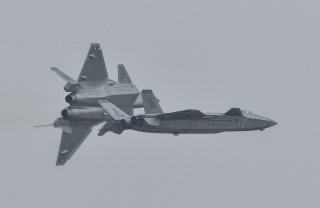China's J-20 Is Good But It Remains Untested
Xi Jinping has told his military to focus on "preparing to go to war," and the drills with the J-20 certainly suggest that military leaders are heeding that call.
Here's What You Need to Remember: If the People's Liberation Army Air Force (PLAAF) finds itself in armed conflict it remains unclear if the aircraft would give it the edge over its rivals. It could face Taiwan's advanced F-16 fighter jets or India's new French-built Dassault Rafale.
Beijing remains a bit of an enigma when it comes to military hardware. On the one hand, China has worked hard to keep many of its platforms under wraps, but at the same time, it also can't help showing off some of its latest and greatest hardware advances in the state media. The Chengdu J-20 – also known as the Mighty Dragon – is such an example. While all of the aircraft's capabilities are still unknown, a pair of J-20s was seen flying high in combat training exercises on state television channel CCTV.
In the brief footage the single-seat, twinjet, all-weather fifth-generation fighter aircraft employed dozens of decoy flares, which are typically used during dogfights to counter heat-seeking missiles. The drills involving the warplane were likely meant as a show of force to foreign eyes as much as a way to highlight the capabilities of the aircraft to the domestic eyes, suggested The South China Morning Post newspaper.
The timing of the release of the video of the stealth aircraft coincides with escalating tensions in the South China Sea, across the Taiwan Strait, and notably on the border with India, where Beijing and New Delhi have deployed troops, tanks, and aircraft.
Chinese President Xi Jinping has told his military to focus on "preparing to go to war," and the drills with the J-20 certainly suggest that military leaders are heeding that call. While it seems unlikely Beijing will send up the balloon, these drills of military hardware have been increasing. Last month a J-20 was seen over the city of Quzhou in Zhejiang, just 20 minutes away by air from Taiwan.
China had also previously touted the capabilities of the aircraft, including that its reported range of 700 miles would allow it to operate over potential hotspots such as the South China Sea.
Is the J-20 Up to the Task?
If the People's Liberation Army Air Force (PLAAF) finds itself in armed conflict it remains unclear if the aircraft would give it the edge over its rivals. It could face Taiwan's advanced F-16 fighter jets or India's new French-built Dassault Rafale.
While a highly capable aircraft, the J-20 has had numerous issues, and China has struggled to build sufficiently powerful enough engines for the aircraft. Earlier this year it was reported that China had even opted to employ a foreign design made by Russia. That may give the J-20 the added boost it needs, and the aircraft will likely become more capable as time goes on. Another factor however is the number of J-20s that are in service, but it is believed that Beijing has at least 50 of the stealth aircraft.
China and India have already engaged in a dogfight of sorts – not with the actual planes of course but rather in a war of words with each side claiming their respective fighter is superior to its rival. India's Air Force chief boasted that the Rafale was more advanced than the J-20 while China fired back that its aircraft is the superior fighter. For now, at least the two aircraft haven't engaged in actual combat – and hopefully, that won't occur.
Peter Suciu is a Michigan-based writer who has contributed to more than four dozen magazines, newspapers and websites. He is the author of several books on military headgear including A Gallery of Military Headdress, which is available on Amazon.com.
This article first appeared in October 2020 and is being reprinted for reader interest.
Image: Wikimedia Commons

